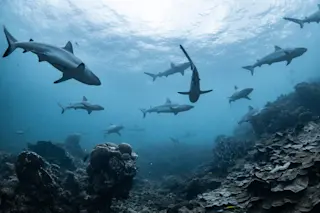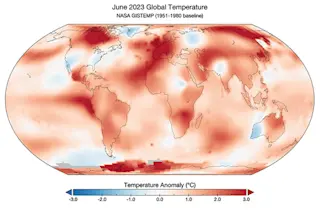Something strange is brewing inside a former ice-cream factory on Florida’s Gulf Coast. There, in a small marine laboratory, stands a clear tube, 6 feet high and 8 inches in diameter, filled with ordinary seawater from the mouth of Tampa Bay. The only sound is the hum of a high-pressure water pump. Ethane, a hydrocarbon gas, is fed into the bottom of the tube. Within minutes tiny crystal shards float to the surface. To the untrained eye they look like bubbles, but the magnified picture on a nearby video monitor shows an icelike consistency. “At first we thought it was dust or something,” says Sarah Holman, a chemical engineer. “Now we know it’s hydrate, and it’s forming almost immediately.” Gradually, larger masses begin to form. A layer of frosty material gathers at the top of the tank, like salt on the rim of a giant margarita. As more and more accumulates, it begins to look like an Italian ice slowly filling the top of the tank.
This is the first step in what could be a revolution in wringing freshwater from the sea. When hydrates form, even in the ocean, salt is excluded from the crystalline structure. Melt the hydrate and it separates into distilled water and gas. Build a large enough structure—say, a tube a thousand feet or longer on the shore or in the sea itself—and you could provide freshwater for an increasingly arid planet, which could quite literally change the world. That is exactly the result Marine Desalination Systems founder Michael Max is gunning for.
Max is one of the world’s ranking experts on hydrates, and he isn’t shy about it. Before you can offer a basic greeting, let alone pull out a pen, he is making declarations: “Up to 500 million gallons of freshwater a day, that’s the goal. . . . Ours is the only group making hydrates from seawater. . . . We’re aiming at a new method that will become a primary source of freshwater on the planet.” At 5 feet 8 inches, Max, 62, is rugby-player stocky with bushy eyebrows, a thick mustache, and all the subtlety of a bulldozer. Arms crossed, he spews out mile-a-minute descriptions of thousand-foot shafts in the sea, where the familiar physics of crystallization, gravity, and pressure gradients will separate salt and produce distilled water.
The key ingredient is gas hydrate, a substance that forms when hydrocarbon gases like methane and ethane come into contact with water at the right temperature and pressure. Gas molecules become trapped inside a lattice structure of water, creating a crystal substance known as clathrate that is superficially similar to ice—except this stuff is flammable. (For more on naturally occurring hydrates, see “Will the Methane Bubble Burst?” in the March 2004 issue of Discover.)
Prior to the 1970s, hydrates were thought of only as nuisances, because they can plug oil and gas pipelines in the field. In the past few decades, however, interest in hydrates has soared, especially in petroleum-poor countries like Japan. Gargantuan stores of gas hydrates under the oceans and permafrost regions of the globe have many scientists wondering whether they can find an economically feasible way to unlock the methane, creating a natural gas supply that could last for centuries. For Max, though, it’s not the gas component of hydrates that has him transfixed; it’s the surrounding molecules of H20.
Max’s curiosity about hydrates began during the 1980s, when he worked as a marine geophysicist for the Naval Research Laboratory. The Navy wanted to know if hydrates under the seafloor were interfering with acoustic signals picked up by an underwater hydrophone array used by the military to track Soviet subs. As the properties, quantities, and potential impact of this mysterious substance began to add up, Max became hooked.
In the mid-1990s, Peter Brewer, a high priest of hydrate research, assisted by Keith Kvenvolden of the U.S. Geological Survey, used a remotely operated vehicle off the California coast to see if releasing compressed gas into small tubes of seawater at depth would result in the spontaneous formation of hydrate. It did, almost instantly. Brewer, who works at the Monterey Bay Aquarium Research Institute, took a video from the experiments to the Naval Research Laboratory in Washington, D.C. “When we showed the video, the response was: ‘Wow. We never knew you could do that,’” recalls Brewer.
“That was truly a seminal moment in hydrate research,” Max says. “When I looked at that video and saw the hydrate floating to the top of those tubes underwater, I thought, ‘What if we had a tube going all the way from where hydrates form at depth to the [ocean] surface?” Max knew what would happen—or should happen—and his desalination idea was born.
Instead of traditionally expensive and difficult methods of removing salt and other impurities from seawater, Max wants to do it naturally. Hydrate crystals are composed exclusively of gas and water molecules, ergo no salt. Yet without
something holding the crystals down, natural-gas hydrates will float up from the deep because they are less dense than the surrounding salt water. (Hydrates formed with carbon dioxide, however, will sink because they are denser than most seawater.) As hydrates rise toward the surface, seawater pressure diminishes, forcing the crystals to melt. That unlocks the gas from its icy cage, a cage made of freshwater. Because that newly released water is less dense than both seawater and hydrate-seawater mix, it will rise as well.
Fast-forward from that first lightbulb moment with the video through a couple of years refining the idea, patent approval, and the formation of Marine Desalination Systems in 1999 to the procurement of federal funding in 2001, and Max is in St. Petersburg, Florida, with a lab in a refurbished 1927 art deco building where Sealtest once made cherry-vanilla ice cream.
Max’s concept for a freshwater reactor is a giant column in the ocean or along a coast, perhaps 1,000 or 1,500 feet long, with pressurized gas pumped in at the base to foster hydrate growth and create what looks like a dynamic four-layered cocktail: seawater and hydrates at the bottom, hydrates rising and melting in the midsection, pure water in the upper area, and gas at the very top. The market-ready freshwater would be pumped out, and the gas would be recycled. The idea is reminiscent of a perpetual motion machine, says Kvenvolden. “It is so visionary. I don’t know why I didn’t think of it!”
The simplicity of the system gives it a Zen-like aura that makes Max a little giddy. “There’s almost nothing an engineer would recognize,” he says. “We don’t filter or pressurize anything.” The fundamentals are sound, says Ed Peltzer, a hydrate expert at the Monterey Bay Aquarium Research Institute. “It is a really elegant application of some pretty esoteric chemistry.”
If it works. The concept of using hydrates is brought up every few years as if it were a new idea, says Raphael Semiat of the Rabin Desalination Laboratory at the Technion-Israel Institute of Technology. “But it is not new.” For more than two decades, researchers have seen the potential energy savings of this approach. But efforts to use hydrates for desalination have all failed for the same reason. They produced thin shells of hydrate surrounding gas bubbles. When that happens, too much seawater clings to the crystal clumps, creating a slurry mess. It is nearly impossible to sequester much freshwater from slurry because the crystals have to be washed clear of residual salts.
“Liquid will stick in a crystal system,” says Kevin Price, a water-treatment expert with the U.S. Bureau of Reclamation. “Can he [Max] guarantee that his system is different? If not, he will need to wash the crystals.” Jim Birkett, a water-technology consultant and former president of the International Desalination Association, recently purged all the hydrate-related literature from his office, deciding once and for all that the concept has no future.
“Everyone failed because they formed slurry,” concedes Max. “But we go completely around that.” The masterstroke is the long column. Because natural mechanisms drive the desalination process, Max says, there is no need to mechanically remove crystals or hydrate chunks from the seawater. And thanks to the natural gradient within the shaft, only the purest water floats to the top, while any salt entrained within the clumps of hydrate floating upward will not qualify, so to speak, for the uppermost batch of freshwater.
But Max agrees that the column alone will not guarantee a slurry-free process. He will need bulky hydrate crystals to do that. He says he’s close, using a technique he will not discuss. What he will share is part of his strategy for growing hefty hydrates: Increase the concentration of gas to saturate the seawater. He uses ethane as a proxy in the lab but will probably use mostly methane with a little ethane for the real thing. Instead of just bubbling the gas into the system, which would result in candy-shell crystals and a quick trip to Slurryville, Max plans to carefully dissolve the gas into the seawater.
“We’ve proved seawater pumped up with gas can make a lot of hydrate,” says Sarah Holman, who is a soft-spoken counterweight to Max’s bold personality. “Other labs, using fresh or distilled water, wait days for small amounts of hydrate to form.”
But perfectly controlled growth is another matter. “What we want is lean and hungry growth,” says Max. In other words, what he needs are not snowflakes of hydrate floating up the water column but chunks in an upward blizzard. Without robust crystal growth, the resulting hydrates will not have sufficient mass to deliver a significant amount of water.
Even if Max can get potable water from the top of his reactor, will such a system ever be commercially viable? To a certain extent, desalination is easy. “Take a bunch of seawater, squeeze it, pump gases through it, heat it, et cetera, and at some level, you can get most of the salt out,” says desalination consultant Birkett. But getting from that point to a competitive technology is an exponentially greater challenge.
The two proven approaches to desalination—heating water and then distilling it, or using an osmotic filter—have reached a level of maturity at which they can be economically workable, but only when getting freshwater from traditional sources is either impossible or too expensive. Pricey distillation plants, for example, are concentrated in the oil-rich states of the Middle East.
Most of the 15,000 desalination plants in the world employ a technology known as reverse osmosis. Powerful pumps force seawater against membranes that let pure water through and filter out the impurities. Since 1980, reverse osmosis has doubled its production capacity, in large part because of gains in membrane efficiency and life span. The costs have come down as well.
But constructing and maintaining a reverse-osmosis facility is still difficult and expensive. The largest desalination plant in the United States is in Tampa Bay, less than 20 miles from Max’s lab, and it has been off-line for months. The membranes used for pretreating the seawater—larger, particulate matter must be removed before the seawater is flushed against the high-tech desalting membranes—are clogged with colonies of tiny Asian green mussels. There also is the brine-disposal issue, or as it has been euphemistically dubbed within the industry, concentrate management. Desalination plants produce tons of unwanted salts.
But the greatest limitations to existing desalination plants are the cost of replacing membranes and the expense of the energy necessary to run the machinery. And that keeps a window of opportunity open for Max. He declines to reveal much, but when asked if his process could produce 1,000 gallons of water for 10 to 12 kilowatt-hours of energy—the rate to beat for any new technology—he nods and allows a rare silence to linger. “Let’s just say we’ll be competitive with freshwater at the going rate,” he says. A few months later he says computer models have put his costs at under 10 kWh per 1,000 gallons.
Max’s system offers some specific advantages that are difficult to measure in dollars, such as the prospect of a plant that doesn’t have to be stopped for months to clean filters or to service corroding equipment. Max’s invention also avoids a brine- disposal issue by removing only a small amount of freshwater at a time, about 5 percent per volume of seawater in the reactor. As a result, outflow should always remain within the natural variability of the oceans’ salinity.
Max’s research is timely. Reverse osmosis may be reaching the limits of its efficiency, and distillation plants remain expensive. Meanwhile, purification efforts to clean up polluted rivers, lakes, streams, and wells cannot meet the world’s growing water needs, and water shortages are already causing human and ecological suffering on a haunting scale. The United Nations estimates that more than a billion people lack adequate freshwater.
Is it possible the optimal chunk of hydrate simply does not exist? Might the reactor be destined to produce flurries of little crystals and never the larger masses of hydrate that float through Max’s dreams? “We know that the optimal chunk exists because we see it in nature,” says Holman.
Fishermen have pulled up basketball-size chunks of hydrate in their nets, and other researchers have scooped it from beneath the ocean floor. Nonetheless, Max may not be able to consistently and rapidly grow large enough chunks of hydrate to deliver freshwater at a good enough price.
“If I say we’re inches from success, it’s the same thing as saying I’ve reached an insurmountable barrier,” Max says. In other words, achieving optimal crystal growth may require only a bit more tweaking, or it may prove impossible. It’s an honest, true-to-science admission, but, as Kvenvolden puts it, “Max has bet the farm on this idea. You’ve got to admire that kind of visionary. And I think it will work.”













